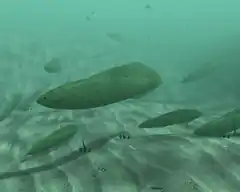Haikouichthys
Haikouichthys /ˌhaɪkuˈɪkθɪs/ is an extinct genus of craniate (animals with notochords and distinct heads) believed to have lived 525 million years ago, during the Cambrian explosion of multicellular life. Haikouichthys had a defined skull and other characteristics that have led paleontologists to label it a true craniate, and even to be popularly characterized as one of the earliest fishes. Cladistic analysis indicates that the animal is probably a basal chordate or a basal craniate;[1] but it does not possess sufficient features to be included uncontroversially even in either stem group.[2][3] It was formally described in 1999.[4]
| Haikouichthys | |
|---|---|
 | |
| Restoration | |
| Scientific classification | |
| Kingdom: | Animalia |
| Phylum: | Chordata |
| Superclass: | Agnatha |
| Order: | †Myllokunmingiida |
| Family: | †Myllokunmingiidae |
| Genus: | †Haikouichthys Luo et al., 1999 |
| Species: | †H. ercaicunensis |
| Binomial name | |
| †Haikouichthys ercaicunensis Luo et al., 1999 | |
Description

Haikouichthys is about 2.5 cm (1 in) long and is narrower than Myllokunmingia, another putative chordate that comes from the same beds. The holotype of Haikouichthys ercaicunensis was found in the Yuansshan member of the Qiongzhusi Formation in the 'Eoredlichia' Zone near Haikou at Ercaicun, Kunming City, Yunnan, China,[3] hence its name "Haikou fish from Ercaicun". The fossil was recovered among the Chengjiang fauna, in one of a series of Lagerstätten sites where thousands of exquisitely preserved soft-bodied fossils have already been found.[5] Following the discovery of the holotype, additional Lower Cambrian fossils of Haikouichthys ercaicunensis have been discovered.[3]

The animal has a distinct head and tail. The head has at least six and perhaps nine probable gills. There are a number of segments (myomeres) with rear directed chevrons in the tail. There is a notochord. There is a prominent dorsal fin with fin radials similar, but not comparable, to those of hagfish and lampreys.[6] The fin radials seem to angle "forward" toward the end thought on the basis of internal structures to be the head. This happens with a few modern fish but is an uncommon arrangement. There are 13 circular structures along the bottom that may be gonads, slime organs, or something else entirely.
See also
- Ostracoderm
- Arandaspis
- Pikaia – Cambrian chordate
- Myllokunmingia – close relative
- Zhongjianichthys – eel-like close relative
- Lancelet – living animal with similar morphology
References
- "Archived copy". Archived from the original on 2009-04-29. Retrieved 2009-04-20.CS1 maint: archived copy as title (link)
- Donoghue, P.C.J.; Purnell, M.A. (2005), "Genome duplication, extinction and vertebrate evolution" (PDF), Trends in Ecology & Evolution, 20 (6): 312–319, doi:10.1016/j.tree.2005.04.008, PMID 16701387, archived from the original (PDF) on 2008-12-17, retrieved 2008-11-06
- Shu, D. G.; Morris, S. C.; Han, J.; Zhang, Z. F.; Yasui, K.; Janvier, P.; Chen, L.; Zhang, X. L.; Liu, J. N.; Li, Y.; Liu, H. -Q. (2003), "Head and backbone of the Early Cambrian vertebrate Haikouichthys", Nature, 421 (6922): 526–529, Bibcode:2003Natur.421..526S, doi:10.1038/nature01264, PMID 12556891
- D. Shu; et al. (1999). Lower Cambrian vertebrates from south China. Nature, 402: 42-46
- BBC News "Oldest fossil fish caught", 4 November 1999
- Zhang, X.G.; Hou, X.G. (2004), "Evidence for a single median fin-fold and tail in the Lower Cambrian vertebrate, Haikouichthys ercaicunensis", Journal of Evolutionary Biology, 17 (5): 1162–1166, doi:10.1111/j.1420-9101.2004.00741.x, PMID 15312089